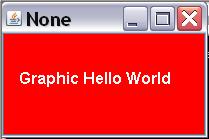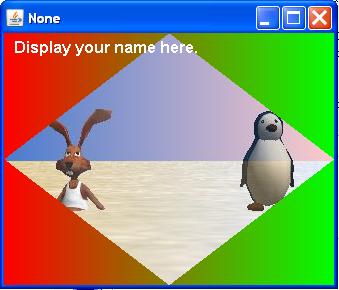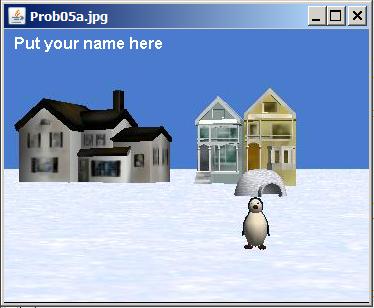| << Chapter < Page | Chapter >> Page > |
| Listing 4 . Question 11. |
|---|
import java.awt.Color;
class GraphicHelloWorld{public static void main(String[] args){PictureExplorer pix = new PictureExplorer(200,100);
pix.setAllPixelsToAColor(Color.RED);pix.addMessage("Graphic Hello World",15,50);
pix.show();}// end main
}//end class |
Figure 1 - Question 11.

True or false? The program shown (incorrectly) in Listing 4 and correctly in Listing 5 requires the use of Ericson's multimedia library plus a jpg image file.
What is the meaning of the following two images?
This image was inserted here simply to insert some space between the questions and the answers to keep them from being visible on the screen at thesame time.
The image is also an example of the kinds of things that we do in my course titled ITSE 2321, Object-Oriented Programming.

This image was also inserted for the purpose of inserting space between the questions and the answers.

False. The program does require the use of Ericson's multimedia library but it does not require a jpg image file.
False. The correct code is shown in Listing 5 .
| Listing 5 . Answer 11. |
|---|
import java.awt.Color;
class GraphicHelloWorld{public static void main(String[] args){Picture pix = new Picture(200,100);
pix.setAllPixelsToAColor(Color.RED);pix.addMessage("Graphic Hello World",15,50);
pix.show();}// end main
}//end class |
True
True.
True.
True.
False. You will need to put the path to the bookClasses folder on your classpath in order to incorporate classes from the library into your programs.
True
False. Once you have downloaded the zip file containing the library, you will need to extract the folder named bookClasses from the zip file and store it somewhere on your computer's disk.
False. The Guzdial-Ericson library was originally published by Guzdial and Ericson in conjunction with their book Introduction to Computing and Programming with Java: A Multimedia Approach . While the book isn't free, the library is freely available and is publishedunder a Creative Commons Attribution 3.0 United States License .
True.
False. The multimedia class library was developed and made available by Mark Guzdial and Barbara Ericson of the Georgia Institute of Technology.
This section contains a variety of miscellaneous information.
Financial : Although the Connexions site makes it possible for you to download aPDF file for this module at no charge, and also makes it possible for you to purchase a pre-printed version of the PDF file, youshould be aware that some of the HTML elements in this module may not translate well into PDF.
I also want you to know that, I receive no financial compensation from the Connexions website even if you purchase the PDF version ofthe module.
In the past, unknown individuals have copied my modules from cnx.org, converted them to Kindle books, and placed them for sale onAmazon.com showing me as the author. I neither receive compensation for those sales nor do I know who does receive compensation. If youpurchase such a book, please be aware that it is a copy of a module that is freely available on cnx.org and that it was made andpublished without my prior knowledge.
Affiliation : I am a professor of Computer Information Technology at Austin Community College in Austin, TX.
-end-

Notification Switch
Would you like to follow the 'Object-oriented programming (oop) with java' conversation and receive update notifications?